Household Casebearer, Plaster Bagworm
Scientific Name: Phereoeca uterella
Order & Family: Lepidoptera, Tineidae
Size: Larval case: 10-15 mm (0.4-0.6 inches) long; Adult moth: wingspan of 10-14 mm (0.4-0.55 inches).

Natural Habitat
Indoors, they are commonly found in closets, attics, storage areas, under furniture, or wherever woolen goods, furs, or other susceptible materials are stored. They prefer high humidity. Outdoors, they can be found on rough surfaces like brick, stucco, or under eaves, feeding on spiderwebs and detritus.
Diet & Feeding
Larvae feed on natural fibers, including wool, silk, fur, felt, and sometimes synthetic blends if mixed with natural fibers. They are also known to consume spiderwebs, pet hair, and dander. Outdoors, they may feed on lichens or algae.
Behavior Patterns
Case-bearing insects live inside a protective case they build from silk and environmental debris, such as lint, fabric fibers, or sand. They carry this case with them as they move and grow, enlarging it as needed. They are typically slow-moving and prefer dark, undisturbed areas. Larvae are the damaging stage, feeding on natural fibers. Adult moths are typically poor fliers and are not attracted to light, unlike many other moth species.
Risks & Benefits
Potential risks include damage to clothing, carpets, tapestries, and other items made of natural fibers. They are not known to transmit diseases or directly harm humans. Benefits are minimal, though they can help break down organic detritus in outdoor environments.
Identified on: 9/4/2025